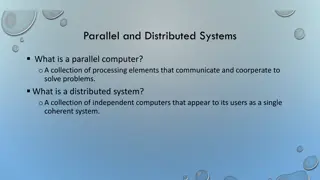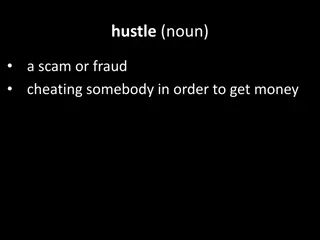Safeguarding Devices and Edge Computing: A Responsive Anti-Scam Approach
The article discusses the prevalence of scamming in the digital landscape, emphasizing the financial harm and security risks it poses. It explores the challenges in detecting scam messages, particularly in short messaging platforms, and proposes a comprehensive and adaptive strategy to address this issue effectively. The research highlights the need for tailored identification approaches for scam messages and the limitations faced by existing anti-spam methods.
Download Presentation

Please find below an Image/Link to download the presentation.
The content on the website is provided AS IS for your information and personal use only. It may not be sold, licensed, or shared on other websites without obtaining consent from the author. Download presentation by click this link. If you encounter any issues during the download, it is possible that the publisher has removed the file from their server.
E N D
Presentation Transcript
Safeguarding Devices and Edge Computing: A Responsive Anti-Scam Approach Chalee Vorakulpipat, CISSP, CISA, PMP National Electronics and Computer Technology Center (NECTEC) Soontorn Sirapaisan, Montida Pattaranantakul, Soontaree Songserm 1
Contents Introduction Literature Review What is Scam? The Proposed Method Evaluation Conclusions 2
Introduction Scamming is a prominent cybercrime in the digital landscape, causing financial harm and compromising user security. Scam messages can tarnish the reputation of hacked or spoofed senders, even if they are not directly involved. Insufficient digital literacy makes many individuals susceptible to scams, struggling to distinguish fraudulent messages from regular spam. Scamming targets users of conventional devices, edge devices, and individuals connected through the Internet of Things (IoT). Addressing this issue requires a comprehensive and adaptive strategy. 3
Literature Review Anti-spam methods have been extensively researched and developed over time [1]. Techniques range from machine learning algorithms [2,3] to human interaction proofs (HIPs) [4,5]. Existing methods often struggle with short messages in platforms like SMS or WhatsApp due to limited metadata [6,7,8]. Scammers exploit these channels to deceive victims, targeting mobile phones and IoT devices [8]. 4
Literature Review (cont.) Intentionally crafted scam emails evade detection by conventional automated schemes [8]. Scam messages require distinct identification approaches tailored to their deceptive nature. Addressing scam messages in short-messaging platforms is crucial due to their widespread use and ease of transmission. Effective anti-scam methods should consider the limitations of short messages and the deceptive nature of scam content. 5
What is Scam? Scam messages are distinct from spam in their intent to deceive individuals and cause financial harm, while spam is primarily an annoyance. Scam messages can be crafted by both real humans and legitimate users, making them difficult to detect using conventional anti-spam tools. 6
What is Scam? (cont.) Messages requesting money or items sent by known individuals (such as colleagues, relatives, business partners, or even family members) may be perceived as legitimate or, at the very least, warranting careful verification before labeling them as scams or spam. False negative detections inevitably lead to losses, but false positives are occasionally overlooked and deemed less significant. 7
Categorization Message received Decision Result Genuine scam messages (either created by humans or robots) False negative (Unfavorable) If a recipient trusts Good If a recipient ignores (Favorable) Good (Favorable) False positive (Unfavorable) Non-scam or scam lookalike messages scam (created by humans) If a recipient trusts If a recipient ignores 8
The Proposed Method The recipient is not required to possess knowledge of the sender's alternative contacts (such as additional email addresses, phone numbers, or messaging IDs). Rather, the recipient needs to possess at least partial information about the sender. The sender has the capability to respond and verify their authenticity to the recipient, regardless of whether the communication is deemed a scam or a legitimate interaction. This confirmation process can take place with or without the divulgence of the sender's alternative contact details. Unlike existing anti-spam tools that demand financial investment and human involvement for setup, our approach does not necessitate extra hardware or software/agents on either the email server or recipient side. 9
Recipient Alert Recipient Alert User Interface User Interface 11
Recipient Recipient Interface Interface Design Design (Recipient's (Recipient's Perspective) Perspective) 13
A Comparison between Existing Anti-spam tools and our Scheme Functions Existing anti-spam tools Our proposed scheme Detection of Scams Crafted by Humans (Compromised Accounts) Detection of Scams Crafted by Humans (Impersonation/Fake Accounts) Accuracy X X Limited: Primarily reliant on machine processing with minimal human interpretation. High: Empowers recipients to assess the legitimacy of scams, fostering co-creation between senders and recipients. Involves additional hardware or software installation on the recipient side (either server or client). Demands significant effort for installation and investment in tool acquisition. Requires no supplementary installation or effort on the recipient side, thus minimizing associated expenses. Imposes no installation requirement on recipient-side servers, making it straightforward and feasible to build the platform from scratch. Cost/Usability Reproducibility 14
Conclusions Our approach empowers recipients to authenticate the authentic sender and make informed judgments regarding the legitimacy of messages. In terms of preserving privacy, our platform ensures that when sending an alert, recipients need not reveal their identity. They only require the sender's address. Regarding security, even if a hacker compromises a sender's account to dispatch a scam message, infiltrating all of the sender's contact addresses proves challenging. Consequently, the sender can still receive alerts from other accounts. 15
Conclusions (cont.) In terms of cost, our scheme's centralized nature eliminates the need for any additional hardware or software installation on the recipient's end, distinguishing it from existing anti-spam tools. An additional distinctive facet of our scheme is the active involvement of genuine senders. 16
Acknowledgements This work is the output of ASEAN IVO project (https://www.nict.go.jp/en/asean_ivo/index.html) entitled Agricultural IoT Based on Edge Computing , and financially supported by NICT (http://www.nict.go.jp/en/index.html). 17
References (selected) [1] J ez-Martino, F., Alaiz-Rodr guez, R., Gonz lez-Castro, V., Fidalgo, E., & Alegre, E. (2023). A review of spam email detection: analysis of spammer strategies and the dataset shift problem. Artificial Intelligence Review, 56(2), 1145-1173. [2] Ahmed, N., Amin, R., Aldabbas, H., Koundal, D., Alouffi, B., & Shah, T. (2022). Machine learning techniques for spam detection in email and IoT platforms: Analysis and research challenges. Security and Communication Networks, 2022, 1-19. [3] Roy, P. K., Singh, J. P., & Banerjee, S. (2020). Deep learning to filter SMS Spam. Future Generation Computer Systems, 102, 524-533. [4] Vorakulpipat, C., Visoottiviseth, V., & Siwamogsatham, S. (2012). Polite sender: A resource-saving spam email countermeasure based on sender responsibilities and recipient justifications. Computers & Security, 31(3), 286- 298. 18
References (selected) [5] Chellapilla, K., Larson, K., Simard, P. Y., & Czerwinski, M. (2005, July). Computers beat Humans at Single Character Recognition in Reading based Human Interaction Proofs (HIPs). In CEAS. [6] Yang, J. (2019). SMS scam user identification based on SPARK and random forest. Computer Engineering & Science, 41(06), 1136. [7] Maqsood, U., Ur Rehman, S., Ali, T., Mahmood, K., Alsaedi, T., & Kundi, M. (2023). An Intelligent Framework Based on Deep Learning for SMS and e-mail Spam Detection. Applied Computational Intelligence and Soft Computing, 2023. [8] Srinivasarao, U., & Sharaff, A. (2023). Machine intelligence based hybrid classifier for spam detection and sentiment analysis of SMS messages. Multimedia Tools and Applications, 1-31. 19
Thank You 20

 undefined
undefined



























